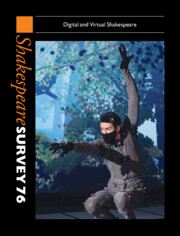Book contents
- Shakespeare Survey 76
- Shakespeare Survey
- Shakespeare Survey
- Copyright page
- Editor’s Note
- Contributors
- Contents
- Illustrations
- All Early Modern Drama Is Virtual to Us
- RSC Live from Stratford-upon-Avon: Ten Things I Think I Know, or, Of Course We’re Making a Movie
- Digital Ariel: An Interview with Mark Quartley
- Staging Digital Co-Presence: Punchdrunk’s Hybrid Sleep No More (2012) And Pandemic-Informed Pedagogies
- ‘Very Tragical Mirth’: Performing A Midsummer Night’s Dream on Screen(s) during Lockdown
- ‘Uneasy Lies the Head’: Michael Almereyda’s Halloween Cymbeline
- When Is King Lear Not King Lear?
- Sim-Ulating Shakespeare: From Stage to Computer Screen
- Metre in the Middle Distance
- ‘What’s in a “Quire”?’ Vicissitudes of the Virtual in Shakespeare’s Julius Caesar and Romeo and Juliet
- ‘And Which the Jew?’: Representations Of Shylock in Meiji Japan (1868–1912)
- Hamlet, Translation and the Linguistic Conditions of Thought
- The Pietas Of Dogberry
- Taylor Mac’s Gary and Queer Failure in Titus Andronicus
- ‘I Would Cure You’: Self-Help Advice on Love in Sidney and Shakespeare
- Shakespeare in Arden: Pragmatic Markers and Parallels
- Sycorax’s Hoop
- Shakespeare Performances in England, 2022
- Peter Kirwan, Productions Outside London
- Professional Shakespeare Productions in the British Isles, January–December 2021
- The Year’s Contribution to Shakespeare Studies
- Abstracts of Articles in Shakespeare Survey 76
- Index
Shakespeare in Arden: Pragmatic Markers and Parallels
Published online by Cambridge University Press: 17 August 2023
- Shakespeare Survey 76
- Shakespeare Survey
- Shakespeare Survey
- Copyright page
- Editor’s Note
- Contributors
- Contents
- Illustrations
- All Early Modern Drama Is Virtual to Us
- RSC Live from Stratford-upon-Avon: Ten Things I Think I Know, or, Of Course We’re Making a Movie
- Digital Ariel: An Interview with Mark Quartley
- Staging Digital Co-Presence: Punchdrunk’s Hybrid Sleep No More (2012) And Pandemic-Informed Pedagogies
- ‘Very Tragical Mirth’: Performing A Midsummer Night’s Dream on Screen(s) during Lockdown
- ‘Uneasy Lies the Head’: Michael Almereyda’s Halloween Cymbeline
- When Is King Lear Not King Lear?
- Sim-Ulating Shakespeare: From Stage to Computer Screen
- Metre in the Middle Distance
- ‘What’s in a “Quire”?’ Vicissitudes of the Virtual in Shakespeare’s Julius Caesar and Romeo and Juliet
- ‘And Which the Jew?’: Representations Of Shylock in Meiji Japan (1868–1912)
- Hamlet, Translation and the Linguistic Conditions of Thought
- The Pietas Of Dogberry
- Taylor Mac’s Gary and Queer Failure in Titus Andronicus
- ‘I Would Cure You’: Self-Help Advice on Love in Sidney and Shakespeare
- Shakespeare in Arden: Pragmatic Markers and Parallels
- Sycorax’s Hoop
- Shakespeare Performances in England, 2022
- Peter Kirwan, Productions Outside London
- Professional Shakespeare Productions in the British Isles, January–December 2021
- The Year’s Contribution to Shakespeare Studies
- Abstracts of Articles in Shakespeare Survey 76
- Index
Summary
The question of who wrote Arden of Faversham remains open. In 1656, publisher Edward Archer (or an associate) assigned the play to Shakespeare in a ‘Catalogue’ appended to his edition of Massinger, Middleton and Rowley’s The Old Law, or A new way to please you.2 Five years later, bookseller Francis Kirkman re-designed the ‘Catalogue’, but this time left the Arden author’s name blank. In 1770, Faversham antiquary Edward Jacob produced an edition of the play ‘With a Preface; in which some Reasons are offered, in favour of its being the earliest dramatic Work of Shakespear’. In defence of this attribution, Jacob’s ‘Preface’ listed a series of verbal parallels between Arden and Shakespeare’s works.3 A little over a century later, Algernon Charles Swinburne deemed the play ‘no man’s youthful hand but Shakespeare’s’.4 In the later twentieth century, MacDonald P. Jackson proposed that the central scenes of the play (in particular, scene 8) belonged to Shakespeare.
- Type
- Chapter
- Information
- Shakespeare Survey 76Digital and Virtual Shakespeare, pp. 163 - 179Publisher: Cambridge University PressPrint publication year: 2023

